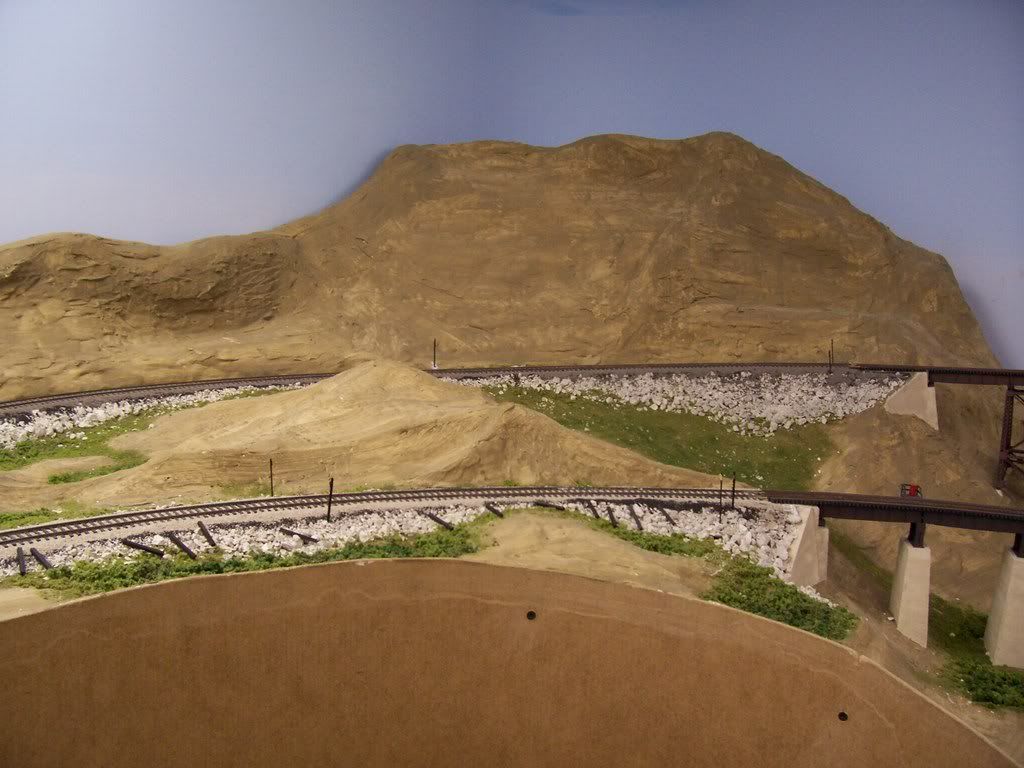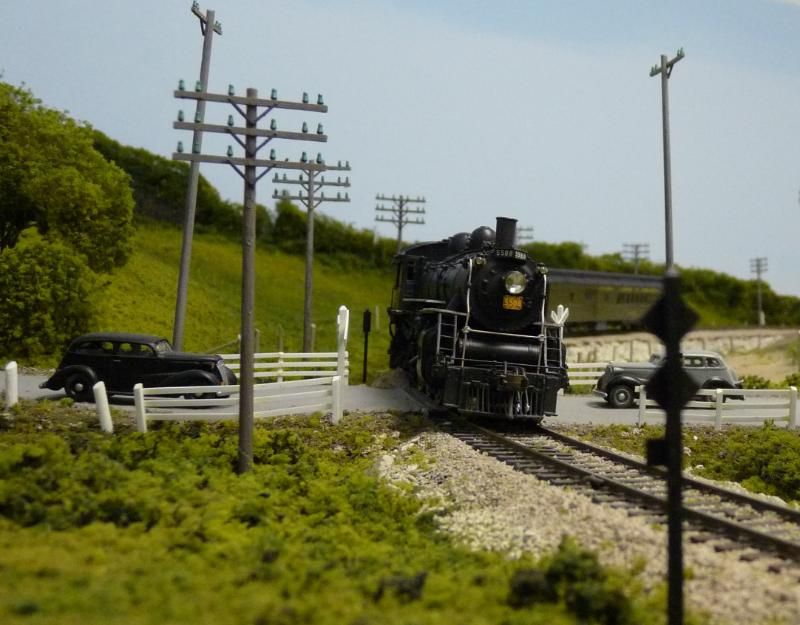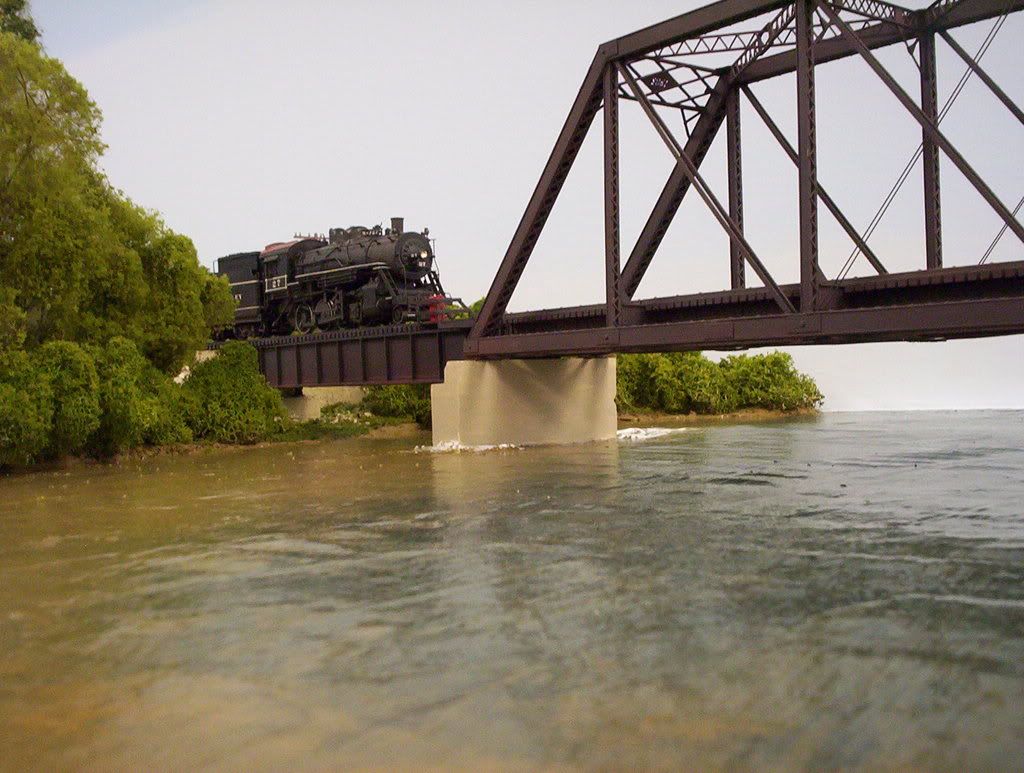I’ve heard hydrocal, sculptamold and now gypsolite. So what’s the difference and how are each used on the model railroad?
Hydrocal is a very fine-grained, white plaster used for casting. It’s great for use with rock face or stone wall molds. Gypsolite, on the other hand, is a gray, gritty material which is good for covering a surface to give it a “natural” look. These are two pictures of my swamp-under-construction, first with a coating of plaster cloth, and then with the Gypsolite (tinted brown with craft paint) spread over it.
I haven’t used scuptamold, so someone else will clue you (and me) in on that.
Sculptamold is a mixture of plaster of paris and some sort of cellulose fibres. It works well, has a reasonably long setting time. When applied it has a somewhat lumpy texture but it can be smoothed a lot with a moist finger or other implement. It can be used to cast items but I have not had much luck making rock castings with it although others report good results.
Joe
This is such a complicated hobby…maybe I should have taken up stamp collecting…appreciate the replies y’all…
I would rather say it’s a hobby with a lot of options. [swg]
I agree with Mr B, it is a variety of options.
I have used both Sculptamold and plaster. Made a large rock face for a curved cut Sculptamold worked well, as after it started to set, I put it in place on the curve, then let it finish curing. I like plaster for casting smaller rock faces a little better. The work time is less. if you want to put them on damp you have to be attentive to how much they have set…
A lot of this hobby is what works best for you. Some folks swear by one method and other folks swear at it…
I have experimented with several methods (for a variety of projects) and find which one I like best. Have found that different methods work better in different situations on the layout. I may agree with poster X on one type of project and am a complete klutz when it comes to doing another project his way.
Have fun,
Richard
Not complicated at all but to do well, requires many skills.
Have been in HO since the late 50’s, have seen many changes, many new products, many older products that went away. Personally on my Santa Fe in Oklahoma I use hydrocal for the base, and sculptamold for the finish scenery. Have done so more years than I want to count and this combination has worked very well for me. Oh, I have used some (I think) molding plaster over the scenery for finish areas requiring carving and casting.
Bob
Anybody remember the old textured plaster that was often recommended back in the 50’s? Gave a somewhat dirt-like texture when applied in a thin coat over regular plaster of paris. I tried to buy some around 1960 at a coouple different hardware stores, before the owner of a good one clued me in. Seems the stuff had Asbestos fibers in it, and the Government was moving to stop it’s use - quietly.
I’ve used Plaster of Paris, Hydrocal, and dental plaster, but all harden too quickly for my tastes. The dental plaster is nice for casting walls and bridge piers and abutments, but too expensive for general landforms. Instead, I use Durabond 90, a patching plaster which sets in approximately 90 minutes. There are other varieties with faster setting times, too. It’s available in home improvement stores in 5 or 10lb. boxes or 33lb. bags. I use a wide putty knife to apply it over aluminum screen, then use a 2" brush, dipped frequently in water, to smooth out the knife marks. It can be mixed in various degrees of stiffness and, once hardened, is very strong. I coloured it with flat interior latex house paint, thinned about 50/50 with water. It’s easier to apply than paint straight from the can, goes farther, and even soaks in somewhat.
Here’s an area that’s been coloured but not otherwise scenicked except alongside the tracks:

…and an area with ground cover applied:

Durabond is tough even when applied in a thin coat. The “water” here, on a plywood riverbed, is only 1/8" thick but hasn’t cracked or been damaged by cameras place atop it.

The bridge piers and abutments were cast with Durabond, too. [swg]
Wayne
I agree that it’s a hobby with a lot of options.
Hydrocal is the generic name for the stuff sold by Woodland Scenics as “Casting Plaster”. Gypsolite is the generic term for what they call “Molding Plaster”. The generics are cheaper and available at hardware stores and home improvement centers. The problem is that both absorb water over time and become crumbly, so make sure if you buy a big bag that you can reseal it somehow. I like hydrocal, and use it over plaster cloth for scenery and for casting rock molds.
Sculptamold is a mixture of plaster of paris (basically hydrocal), shredded newsprint, and white glue. I love the stuff and buy it by the ton. I’ve never had much luck making castings from it, but on the other hand I can use a palette knife to carve it into rock faces as well as man-made features like concrete platforms, loading docks, and retaining walls (covered with styrene or wall card for finished detail). The lumpiness someone mentioned can be controlled by thorough mixing with sufficient water (I like mine to be the approximate texture of oatmeal when I start to apply it). As mentioned above, it can be smoothed with a wet finger before it’s fully cured, and it can be sanded smooth when cured. Sculptamold isn’t as permeable as plaster, so sanding it doesn’t have the adverse affect on staining that sanding plaster does.
And to complicate this even further, There’s hundreds of recepies for “Ground Goop”. All sorts of plaster (gypsom) products mixed w/ various fillers for ground coverings.
Some like plaster cloth or Hydrocal soaked paper towel, Some will just use Sculpamold over a shaped foam base, Then there’s veneering plasters (similar to POP) Unical etc. and then all the combinations that many have found suits they’re needs.
Spanning large “unsupported” (no foam, ply etc"), screening or cardboard lattice, I like to use plaster cloth and added layers of Unical for a thicker “hardshell” Ground Goop of Durabond 90 with various fillers of sawdust, cellulose, Perlite colored w/ corresponding powdered dyes make for a great controlable base. The type/ amount of filler will change the overall texture. The Durabond gives you a decent amount of working time. Some like joint compound, I won’t use it as it is so water soluable and will crack if applied too thick. Durabond will dry hard within an hour even to a thickness of inches and ends up somewhat water resistant.
Hydrocal is a specific brand name of plaster from US Gypsum. Woodland Scenics sells one version of it, and retains the USG brand name. USG has a site with descriptions of its various plaster products here: http://www.plaster.com/Shipping.html .
I think that’s one of those that falls into the category of generic trademarks. Yeah, it’s really “facial tissue” and “hardboard”, but everyone calls it Masonite and Kleenex anyway, no matter what brand it really is. Same deal here. So while you’re technically correct, I think the word is in more general use to describe fine, lightweight plaster.